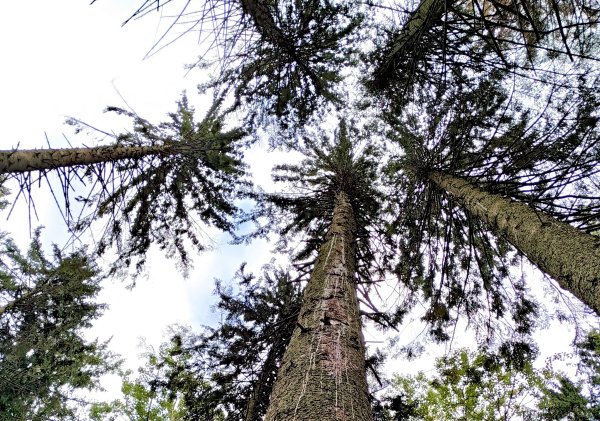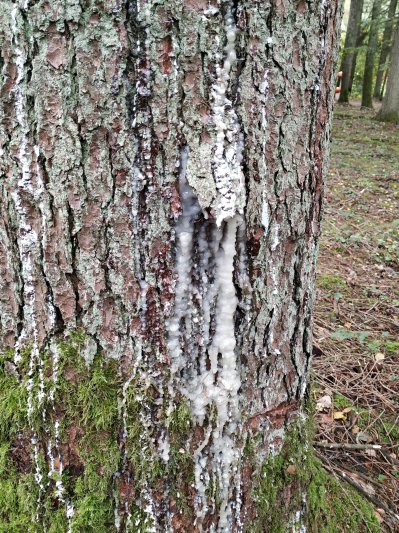LVM Nature Park in Tērvete Continues Fight against the Dangerous European Spruce Bark Beetles
In Latvia’s State Forest Nature Park in Tērvete, the fight against the dangerous forest pest European spruce bark beetle started this year still continues. This autumn, after a warm and long summer, experts of JSC “Latvia’s State Forests” (LVM) discovered trees damaged by European spruce bark beetles in the Fairytale Forest and Old Pine Park near the Rehabilitation Centre. In order to prevent dead trees from endangering the safety of park's visitors, the dangerous areas have been zoned off and the damaged trees are currently being cut down and removed from the park. The works are scheduled to be completed by early November.
“The spruce bark beetle is most often to be found in weakened, overgrown spruce trees that have reached the age of felling or beyond, and there are a plenty of such trees in LVM Nature Park in Tērvete. Moreover, the bark beetle is such an aggressive pest that it attacks and destroys completely healthy spruce trees as well. Unfortunately, our hopeful efforts this spring to limit further spread of bark beetles have been less successful - dozens of damaged trees have been found. This autumn, the pest is already hiding in the ground to hibernate. Let us hope for a harsh frost in winter, so that next spring, the European spruce bark beetle is not able to destroy the great spruce stands in our park,” says Kristaps Didže, Head of LVM Recreation.
The European spruce bark beetle is a typical trunk pest. Spruce trees eliminate bark beetle invasions by the release of resin, which is intensively released when a small number of bark beetles is attacking the tree, however, the tree cannot cope with thousands of simultaneous beetle attacks resulting in a carpet of needles under the mighty fir tree.
In the photo: The European spruce bark beetle is a typical trunk pest that occurs throughout the length of the tree, reaching the highest density in shaded areas. The beetle is dark brown to black, shiny. 1-2 generations develop during a year.
In March of this year, damage caused by the European spruce bark beetle was found in a spruce tree stand near visitors' favourite trails in the Fairytale Forest, where dozens of spruce trees gradually withered. In order to limit the spread of the insect, the trees were cut down. Scientists have come to the conclusion that one solution to eliminate these insects is logging - cutting down and removing dead trees from the forest with all the pests before they can spread further into the adjacent, intact spruce stands.
The cut down spruce trees got a second life - they were recycled into new attractions and tourist facilities. School students of grades 6, 7, and 8 of Anna Brigadere Elementary School took part in the renovation works of the territory this spring. The young people, together with LVM specialists discovered the specifics of forest maintenance and restoration works, explored the principles and importance of sustainable forest management, and learned about forest development, as well as the protection of young trees against damage caused by insects and cervids.
The last time that the European spruce bark beetle caused such damage to the Nature Park in Tērvete was in the late 1990s. Now it has returned after 20 years.
In the photo: Trunk resin of an already damaged spruce.
According to the results of the National Forest Pest Monitoring of the Latvian State Forest Research Institute “Silava” for 2018, the population of European spruce bark beetles increased last year due to the warm summer. According to the SFS data on issued sanitary opinions last year, (as compared to 2017) the number of issued opinions has increased, exactly in order to limit spruce bark beetle damage. While in previous years about 30-50 hectares of forest stands were damaged as a result of spruce bark beetle activity, last year they were 89.8 hectares, but by 1 July this year already 300 hectares of damaged area were recorded.
The largest damage caused by spruce bark beetles this year was observed in an area in Lubāna wetland. To limit further spread of the dangerous spruce pests in the area, an action plan has been developed with recommendations on the order and timing of the removal of the damaged stands and on the placement of pheromone traps to catch flying bark beetles.




